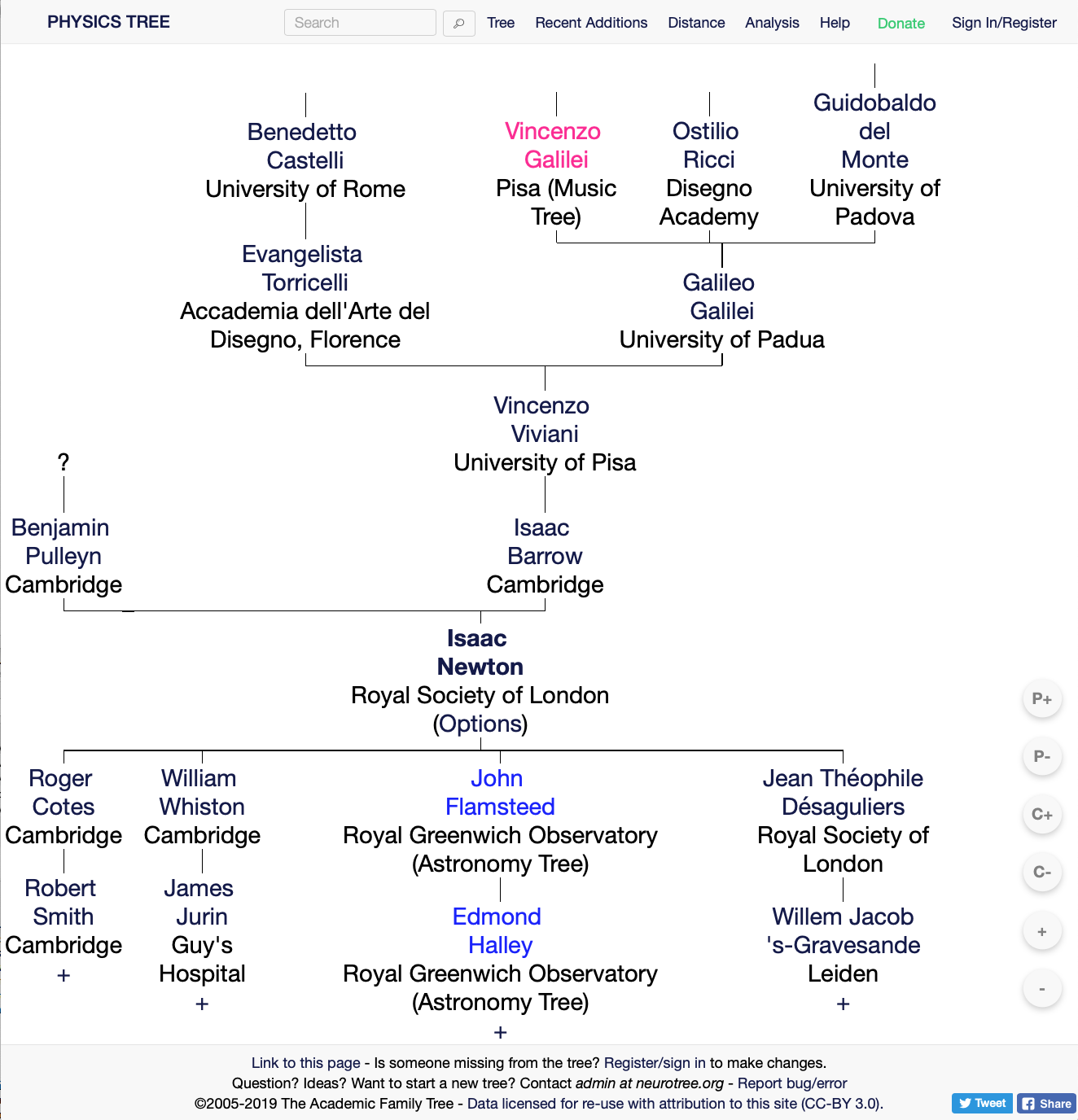|
Academic Lineage
An academic, or scientific genealogy organizes a family tree of scientists and scholars according to mentoring relationships, often in the form of dissertation supervision relationships, and not according to genetic relationships as in conventional genealogy. Since the term ''academic genealogy'' has now developed this specific meaning, its additional use to describe a more academic approach to conventional genealogy would be ambiguous, so the description scholarly genealogy is now generally used in the latter context. Overview The academic lineage or academic ancestry of someone is a chain of professors who have served as academic mentors or thesis advisors of each other, ending with the person in question. Many genealogical terms are often recast in terms of academic lineages, so one may speak of academic descendants, children, siblings, etc. One method of developing an academic genealogy is to organize individuals by prioritizing their degree of relationship to a mentor/advi ... [...More Info...] [...Related Items...] OR: [Wikipedia] [Google] [Baidu] |
Doctoral Supervisor
A doctoral advisor (also dissertation director, dissertation advisor; or doctoral supervisor) is a member of a university faculty whose role is to guide graduate students who are candidates for a doctorate, helping them select coursework, as well as shaping, refining and directing the students' choice of sub-discipline in which they will be examined or on which they will write a dissertation. Students generally choose advisors based on their areas of interest within their discipline, their desire to work closely with particular graduate faculty, and the willingness and availability of those faculty to work with them. In some countries, the student's advisor serves as the chair of the dissertation committee or the examination committee. In some cases, though, the person who serves those roles may be different from the faculty member who has most closely advised the student. For instance, in the Dutch academic system, only full professors (''hoogleraren'') and associate professo ... [...More Info...] [...Related Items...] OR: [Wikipedia] [Google] [Baidu] |
Academia
An academy (Attic Greek: Ἀκαδήμεια; Koine Greek Ἀκαδημία) is an institution of secondary education, secondary or tertiary education, tertiary higher education, higher learning (and generally also research or honorary membership). The name traces back to Plato's school of philosophy, founded approximately 385 BC at Akademia, a sanctuary of Athena, the goddess of wisdom and Skills, skill, north of Ancient Athens, Athens, Greece. Etymology The word comes from the ''Academy'' in ancient Greece, which derives from the Athenian hero, ''Akademos''. Outside the city walls of Athens, the Gymnasium (ancient Greece), gymnasium was made famous by Plato as a center of learning. The sacred space, dedicated to the goddess of wisdom, Athena, had formerly been an olive Grove (nature), grove, hence the expression "the groves of Academe". In these gardens, the philosopher Plato conversed with followers. Plato developed his sessions into a method of teaching philosophy and in 3 ... [...More Info...] [...Related Items...] OR: [Wikipedia] [Google] [Baidu] |
Academic Genealogies
An academy (Attic Greek: Ἀκαδήμεια; Koine Greek Ἀκαδημία) is an institution of secondary or tertiary higher learning (and generally also research or honorary membership). The name traces back to Plato's school of philosophy, founded approximately 385 BC at Akademia, a sanctuary of Athena, the goddess of wisdom and skill, north of Athens, Greece. Etymology The word comes from the ''Academy'' in ancient Greece, which derives from the Athenian hero, ''Akademos''. Outside the city walls of Athens, the gymnasium was made famous by Plato as a center of learning. The sacred space, dedicated to the goddess of wisdom, Athena, had formerly been an olive grove, hence the expression "the groves of Academe". In these gardens, the philosopher Plato conversed with followers. Plato developed his sessions into a method of teaching philosophy and in 387 BC, established what is known today as the Old Academy. By extension, ''academia'' has come to mean the accumulation, dev ... [...More Info...] [...Related Items...] OR: [Wikipedia] [Google] [Baidu] |
Annals Of Neurology
''Annals of Neurology'' is a peer-reviewed medical journal publishing articles of "broad interest in neurology, particularly those with high impact in understanding the mechanisms and treatment of diseases of the human nervous system." The journal has a 2020 ''Journal Citation Reports'' impact factor of 10.422, ranking it 9th out of 208 journals in the category "Clinical Neurology". History The ''Annals of Neurology'' was launched in 1977. Editors The following people have been editors-in-chief of the journal: * Clifford B. Saper, 2018present * Steven L. Hauser, 2006–2013 * Richard T. Johnson, 1997–2005 * Robert A. Fishman, 1993–1997 * Arthur K. Asbury, 1985–1992 * Fred Plum Fred Plum (January 10, 1924 – June 11, 2010) was an American neurologist who developed the terms "persistent vegetative state" and "locked-in syndrome" as part of his continuing research on consciousness and comas and care of the comatose. ..., 1977–1984 References External links * ... [...More Info...] [...Related Items...] OR: [Wikipedia] [Google] [Baidu] |
Glioma
A glioma is a type of tumor that starts in the glial cells of the brain or the spine. Gliomas comprise about 30 percent of all brain tumors and central nervous system tumours, and 80 percent of all malignant brain tumours. Signs and symptoms Symptoms of gliomas depend on which part of the central nervous system is affected. A brain glioma can cause headaches, vomiting, seizures, and cranial nerve disorders as a result of increased intracranial pressure. A glioma of the optic nerve can cause visual loss. Spinal cord gliomas can cause pain, weakness, or numbness in the extremities. Gliomas do not usually metastasize by the bloodstream, but they can spread via the cerebrospinal fluid and cause "drop metastases" to the spinal cord. Complex visual hallucinations have been described as a symptom of low-grade glioma. A child who has a subacute disorder of the central nervous system that produces cranial nerve abnormalities (especially of cranial nerve VII and the lower bulbar nerv ... [...More Info...] [...Related Items...] OR: [Wikipedia] [Google] [Baidu] |
Neurotree
Neurotree is a web-based database for the academic genealogy of neuroscientists. It was established in 2005. Later in 2005, Academic Family Tree began, incorporating Neurotree and academic genealogies of other scholarly disciplines. Unlike a conventional genealogy or family tree, in which connections among individuals are from kinship (e.g., parents to children), connections in Neurotree and the other Academic Family trees are from mentoring relationships, usually among Faculty (academic staff), people working in academic settings (e.g., doctoral supervisor and student). Neurotree and Academic Family Tree have been used as sources of information for the history and prospects of various academic fields such as psychology, meteorology, organizational communication, and neuroscience. Neurotree has also been used to address infometrics and to research issues of scientific methodology. Neurotree and the other academic genealogies of Academic Family Tree are volunteer-run; accuracy is ... [...More Info...] [...Related Items...] OR: [Wikipedia] [Google] [Baidu] |
Notices Of The American Mathematical Society
''Notices of the American Mathematical Society'' is the membership journal of the American Mathematical Society (AMS), published monthly except for the combined June/July issue. The first volume appeared in 1953. Each issue of the magazine since January 1995 is available in its entirety on the journal web site. Articles are peer-reviewed by an editorial board of mathematical experts. Since 2019, the editor-in-chief is Erica Flapan. The cover regularly features mathematical visualization Mathematical phenomena can be understood and explored via visualization. Classically this consisted of two-dimensional drawings or building three-dimensional models (particularly plaster models in the 19th and early 20th century), while today it ...s. The ''Notices'' is self-described to be the world's most widely read mathematical journal. As the membership journal of the American Mathematical Society, the ''Notices'' is sent to the approximately 30,000 AMS members worldwide, one-third of whom ... [...More Info...] [...Related Items...] OR: [Wikipedia] [Google] [Baidu] |
The Chronicle Of Higher Education
''The Chronicle of Higher Education'' is a newspaper and website that presents news, information, and jobs for college and university faculty and student affairs professionals (staff members and administrators). A subscription is required to read some articles. ''The Chronicle'', based in Washington, D.C., is a major news service in United States academic affairs. It is published every weekday online and appears weekly in print except for every other week in May, June, July, and August and the last three weeks in December. In print, ''The Chronicle'' is published in two sections: section A with news, section B with job listings, and ''The Chronicle Review,'' a magazine of arts and ideas. It also publishes ''The Chronicle of Philanthropy'', a newspaper for the nonprofit world; ''The Chronicle Guide to Grants'', an electronic database of corporate and foundation grants; and the web portal Arts & Letters Daily. History Corbin Gwaltney was the founder and had been the editor of t ... [...More Info...] [...Related Items...] OR: [Wikipedia] [Google] [Baidu] |
Mathematics Genealogy Project
The Mathematics Genealogy Project (MGP) is a web-based database for the academic genealogy of mathematicians.. By 31 December 2021, it contained information on 274,575 mathematical scientists who contributed to research-level mathematics. For a typical mathematician, the project entry includes graduation year, thesis title (in its Mathematics Subject Classification), '' alma mater'', doctoral advisor, and doctoral students.. Origin of the database The project grew out of founder Harry Coonce's desire to know the name of his advisor's advisor.. Coonce was Professor of Mathematics at Minnesota State University, Mankato, at the time of the project's founding, and the project went online there in fall 1997.Mulcahy, Colm;The Mathematics Genealogy Project Comes of Age at Twenty-one(PDF) AMS Notices (May 2017) Coonce retired from Mankato in 1999, and in fall 2002 the university decided that it would no longer support the project. The project relocated at that time to North Dakota State U ... [...More Info...] [...Related Items...] OR: [Wikipedia] [Google] [Baidu] |
Academic Lineage
An academic, or scientific genealogy organizes a family tree of scientists and scholars according to mentoring relationships, often in the form of dissertation supervision relationships, and not according to genetic relationships as in conventional genealogy. Since the term ''academic genealogy'' has now developed this specific meaning, its additional use to describe a more academic approach to conventional genealogy would be ambiguous, so the description scholarly genealogy is now generally used in the latter context. Overview The academic lineage or academic ancestry of someone is a chain of professors who have served as academic mentors or thesis advisors of each other, ending with the person in question. Many genealogical terms are often recast in terms of academic lineages, so one may speak of academic descendants, children, siblings, etc. One method of developing an academic genealogy is to organize individuals by prioritizing their degree of relationship to a mentor/advi ... [...More Info...] [...Related Items...] OR: [Wikipedia] [Google] [Baidu] |
Family Tree
A family tree, also called a genealogy or a pedigree chart, is a chart representing family relationships in a conventional tree structure. More detailed family trees, used in medicine and social work, are known as genograms. Representations of family history Genealogical data can be represented in several formats, for example, as a pedigree or . Family trees are often presented with the oldest generations at the top of the tree and the younger generations at the bottom. An ancestry chart, which is a tree showing the ancestors of an individual and not all members of a family, will more closely resemble a tree in shape, being wider at the top than at the bottom. In some ancestry charts, an individual appears on the left and his or her ancestors appear to the right. Conversely, a descendant chart, which depicts all the descendants of an individual, will be narrowest at the top. Beyond these formats, some family trees might include all members of a particular surname (e.g., male-l ... [...More Info...] [...Related Items...] OR: [Wikipedia] [Google] [Baidu] |


